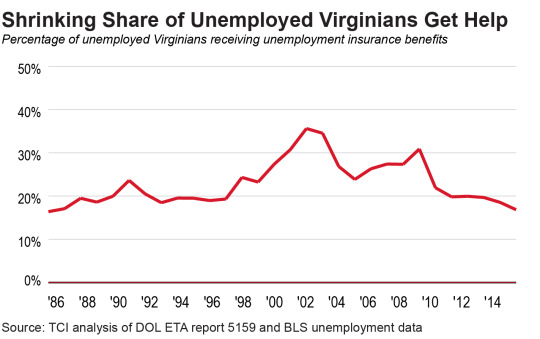March 1, 2016
Something’s Wrong with Unemployment Insurance in Virginia
Virginia’s out-of-date unemployment insurance system didn’t give workers the support they needed during the last recession. Since then, it’s only gotten worse.
Last year, fewer than 1 in 5 unemployed Virginians received unemployment insurance (UI) payments, the lowest level since 1986. Virginia had an average of about 193,000 unemployed persons in 2015, all of whom wanted to work and many of whom were unemployed through no fault of their own. But only about 17 percent of them – an average of 32,500 – actually received unemployment benefits. That’s extremely low, and shows that UI in Virginia isn’t responding to the economy the way it should.

Unemployment insurance is designed to help the most in bad times. When the economy is strong few people file claims because unemployment is relatively low. When the economy is weak many people file claims.
So it makes sense that the people most likely to qualify for UI benefits – full-time workers with long employment histories, who, while laid off, have good prospects for re-employment – are most likely to be unemployed immediately after recessions. The people least likely to qualify for benefits – new workers, part-time workers, long-term unemployed workers, workers with inconsistent work histories, and people who quit their jobs – make up a larger share of the unemployed when the economy is strong.
It’s no surprise, then, that the rate of unemployed Virginians receiving UI has fallen some in the last few years as the state’s economy modestly recovers. But it is surprising that the rate is falling this much. Many Virginians are still unemployed and lack economic opportunity due to structural changes in Virginia’s jobs market, as we recently showed. Furthermore, the current economy is weaker than during the 1990s and early 2000s, when the rate was much higher.
The rate of people receiving UI in Virginia also dramatically lags most other states. On average in the United States, 27 percent of unemployed workers receive unemployment insurance benefits. That’s far higher than Virginia’s 17 percent rate.

But the low percentage of unemployed receiving benefits isn’t the only way Virginia’s unemployment insurance system leaves people behind. Average weekly UI payments in 2014 were just $299 – only 29.7 percent of average weekly wages. And in 2015, the maximum benefit was only $378.
The bottom line is that only a small share of unemployed Virginians receive unemployment insurance benefits, and those who do don’t get much.
Low benefits and fewer workers receiving them are troubling because unemployment insurance is an important way to protect families and the economy from unpredictable and unavoidable changes. It provides temporary relief to unemployed workers – many of whom are unemployed for reasons well beyond their control. It’s also an important stabilizer for the whole economy. When the economy is strong, money is saved up in the unemployment insurance trust fund. When the economy falters, the unemployment insurance program pumps money from that trust fund into the hands of unemployed workers, and out into the local economy as other sources of income, such as wages and salaries, stagnate or even fall. When fewer people who need them receive benefits, unemployment insurance has less power to help families and strengthen the economy when times are bad.
Waiting until the house is on fire is too late for getting insurance that works. Waiting until the next recession is too late to strengthen Virginia’s weak unemployment insurance system – and the next recession is always sooner than people hope. Virginia needs to start thinking now about ways to make sure more workers can receive vital UI payments before it’s too late.
–Aaron Williams, Research Assistant
